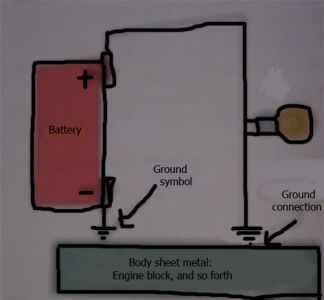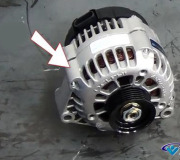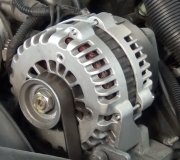OH, ... Sorry for my confusion.
It might help to think of the battery as an expansion tank on a home hydronic heating system or the overflow reservoir on your cooling system. The battery is in parallel with the generator and in parallel with the car's circuitry. Current leaving the generator can go to the car's other systems or it can go to the battery, or both.
Here's a better way of thinking of it. When my students had trouble visualizing something they couldn't see, I always got good results comparing everything to water flow which they COULD visualize. Imagine a city's water pump, a storage tower, and the pipe going to your house. When you're watering the lawn, water flows from the pump to your house. It does not go through the water tower. However, since the pump is capable of pumping more water than you need for your lawn, the extra goes up into the tower. As the level rises in the tower, the pressure goes up thanks to gravity. (Voltage is electrical pressure). Eventually when the pressure gets high enough, a pressure switch, (voltage regulator), tells the pump to turn off for a while. Since you're still watering the lawn, some of the water stored in the tower leaves and goes to your house. Water pressure goes down / battery voltage goes down. The pressure switch turns the pump back on / the voltage regulator turns the generator back on.
If you remove the tower from the picture, the pump will still deliver water to your house but without the cushion, the pressure would skyrocket to maximum instantly, then the switch would turn the pump off and pressure would go to 0 psi instantly. It would cycle very rapidly like that. The pressure switch is reacting to low pressure, but before it can react, your hose might pop due to high pressure.
Similarly, if you remove the battery from the story, the generator will still deliver current to the other circuits, one of which is its own input circuit.
It sounds like part of the confusion is related to the current going THROUGH the battery. No current goes through the battery to get to the other circuits. The current that goes through it is the electrons that are getting absorbed and stored in the plates to be released later. No water goes through the tower to get to your house. Instead, the water is absorbed into the tower to be released later.
In case you understand that description, let me make it more complicated. For current to flow, there must always be a complete path. Technically, electrons leave the negative battery post, but it is much easier and more common for us to start at the positive post. From there, current goes through the wires, fuses, connections, and splices to the load. The load has resistance that limits how much current can flow. (Your hose nozzle is the load). After current goes through the load, it goes back to the battery in the negative post. That's a complete circuit. There will also be one or more methods of switching anywhere in that circuit. That could be a physical switch you control or a transistor inside a computer module.
The generator circuit works the same way. Current leaves the output terminal, goes through the same circuit of wires, fuses, and loads, and goes back in through the case which is the negative / ground return. No battery involved, although the battery could be one of those circuits where the generator's output current is going. Without the generator, the car would operate off the current from the storage battery. Without the battery, the car would operate off the current from the generator. Each system has to be connected to the car's circuitry to work. Since the battery already is, it is common to just run the generator's output wire over to the battery's positive cable because it's convenient. Some cars, GM in particular, run the generator's output wire to the large terminal on the starter because that cable goes back to the battery too. Saves on the amount of wire needed. The generator's negative return is its case bolted to the engine. The battery is connected to that point with the large black cable that is also bolted to the engine.
Another way of looking at it is every circuit in the car has a positive side and a negative side. The battery has a positive supply terminal and a negative return terminal. The generator has a positive supply terminal and a negative return terminal. The positive terminals are all tied together from the battery, generator, and circuits. This is most commonly done at the battery cable, but it doesn't have to be. That's just done for convenience. Similarly, all of the negative terminals must be connected. On fiberglass cars that requires wires that all meet up at one common point, again, typically the battery's negative cable, or possibly the engine, but with metal car bodies, it is real convenient to use the sheet metal to connect everything together.
Caradiodoc
Sunday, May 9th, 2010 AT 8:56 PM





